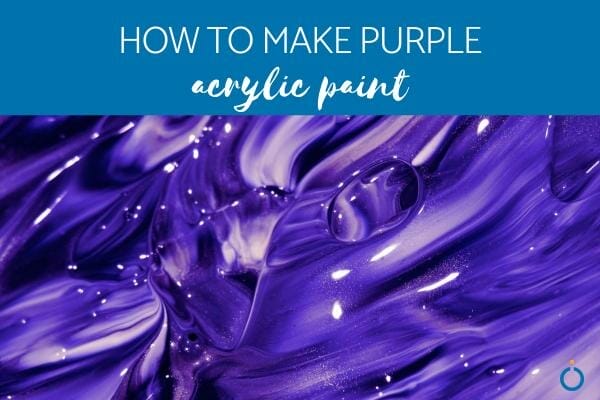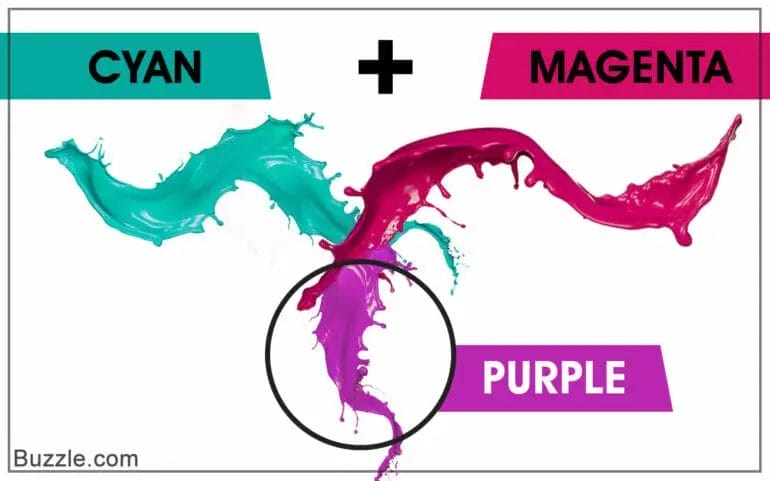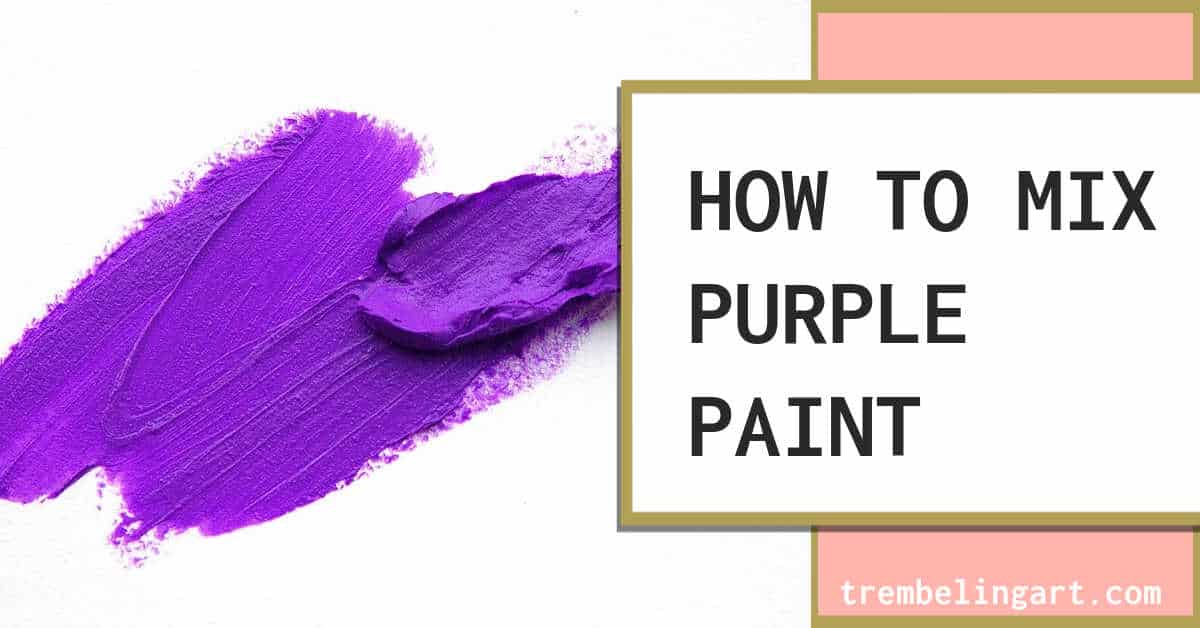If you’re wondering how to make purple with acrylic paint, you’re in the right place! Mixing colors is an essential skill for any artist, and creating purple can be a fun and creative process. To make purple, you’ll need to combine two primary colors: red and blue.
Start by squeezing a small amount of red acrylic paint onto your palette. Next, add an equal amount of blue paint next to the red. Use a clean brush or palette knife to mix the two colors together until you achieve the desired shade of purple.
Remember, the amount of red and blue paint you use will determine the intensity and hue of the purple. Feel free to experiment with different ratios to create unique shades of purple. Happy painting!

Using Secondary Colors to Make Purple
Purple is a beautiful and vibrant color that can add a touch of elegance to any design or artwork. While it is possible to purchase ready-made shades of purple, mixing your own purple using secondary colors can offer a unique and personalized shade. In this section, we will explore how to create purple by using secondary colors.
Understanding Secondary Colors
Before diving into the process of creating purple, it is important to have a basic understanding of secondary colors. Secondary colors are created by mixing two primary colors together. The three primary colors are red, blue, and yellow, and when these colors are combined, they create secondary colors. The secondary colors are green, orange, and purple.
The Color Wheel
To create purple, we need to understand its position on the color wheel. The color wheel is a visual representation of the relationships between colors. It consists of twelve colors, including the three primary colors, three secondary colors, and six tertiary colors.
Purple is located between red and blue on the color wheel. This means that to create purple, we will be combining red and blue, both of which are primary colors. By mixing red and blue together in the right ratios, we can achieve different shades of purple.
Creating Purple
To create purple, start by gathering your materials. You will need red and blue paint, a palette or mixing surface, and a paintbrush. It is recommended to use acrylic or watercolor paint for this process, as they are easily mixable.
- Begin by squeezing a small amount of red paint onto your palette.
- Add an equal amount of blue paint next to the red paint, keeping them separate.
- Using your paintbrush, start mixing the red and blue together. You can do this by either swirling the brush in small circular motions or by gently stroking back and forth.
- As you mix the colors together, you will start to see the purple hue emerge. Keep mixing until the desired shade of purple is achieved.
Remember that the ratio of red to blue will determine the shade of purple you create. For a deeper, more vibrant purple, add more blue. For a lighter, more pastel shade, add more red.
Experimenting with Secondary Colors
Now that you have learned how to create purple by mixing red and blue, don’t be afraid to experiment! The beauty of art and design is the ability to create unique and unexpected colors. Try adding small amounts of other secondary colors, such as green or orange, to your mixture to see how it affects the shade of purple. This can result in interesting and unconventional tones of purple that can truly make your artwork stand out.
In summary, purple is a versatile and captivating color that can be achieved by mixing red and blue, two primary colors. By understanding the color wheel and experimenting with different ratios, you can create a wide range of shades of purple. So, unleash your creativity and start mixing secondary colors to create your own unique and beautiful purple!

Achieving Different Shades of Purple with Acrylic Paint
Acrylic paint is a versatile medium that allows artists to create a wide range of colors and effects. When it comes to purple, there are numerous ways to achieve different shades and tones using acrylic paint. Whether you’re a beginner or an experienced artist, understanding the color theory and various techniques can help you create beautiful and vibrant shades of purple.
1. Mixing Primary Colors
One of the basic methods to create purple is by mixing primary colors – red and blue. Start by squeezing equal amounts of red and blue acrylic paint on your palette. Use a brush or palette knife to blend the colors together until you achieve the desired shade of purple. Keep in mind that the proportions of red and blue will determine the intensity and hue of the purple.
2. Adding White or Black
If you want to lighten or darken your purple shade, you can add white or black paint. By adding white, you will create a lighter shade of purple known as a tint. Start with your base purple color and gradually add small amounts of white, mixing well after each addition, until you achieve the desired tint. On the other hand, adding black to your base purple will create a darker shade, also known as a shade. Experiment with different proportions of black to achieve the depth of color you desire.
3. Color Blending
Another technique to create unique shades of purple is through color blending. This involves blending different colors together to create more complex and nuanced shades. For example, mixing red and blue with a touch of white can create a lighter and more pastel shade of purple. Combining red and purple with a small amount of black can result in a deep and rich shade of purple. Don’t be afraid to experiment and mix various colors to achieve the exact shade you envision.
4. Layering and Glazing
Layering and glazing techniques can also be employed to create interesting shades of purple. Start by applying a base layer of a lighter purple shade and allow it to dry completely. Then, apply a thin layer of a darker purple on top, allowing the base layer to show through. This creates depth and dimension in your artwork. Glazing involves applying a transparent layer of paint over an existing layer of color. By glazing a purple layer over another color, you can create unique undertones and variations in shades.
5. Mixing Complementary Colors
Complementary colors are colors that are opposite each other on the color wheel. Mixing complementary colors can result in vibrant and harmonious shades. For purple, the complementary color is yellow. Experiment with mixing small amounts of yellow paint with your base purple to create interesting shades of purple with a hint of warmth.
6. Use Color Mixing Guide
If you’re unsure about color combinations and ratios, you can also refer to a color mixing guide or chart. These guides provide information on how different colors can be mixed to achieve specific shades. They can serve as a helpful reference, especially for beginners, to create desired shades of purple without the need for extensive experimentation.
Summary
Purple is a captivating color that can evoke a range of emotions and moods. With acrylic paint, you have the freedom to explore and create an array of shades and tones of purple. Whether you prefer a vibrant and bold purple or a soft and subtle shade, utilizing color theory, mixing primary and complementary colors, and experimenting with different techniques like layering and glazing will allow you to achieve the desired effects. So, grab your brushes and palette, and let your creativity flow as you paint with different shades of purple.

Adjusting the Tone of Purple with White or Black
When it comes to creating the perfect shade of purple, adding white or black can significantly alter its tone. By adjusting the amount of white or black, you can either lighten or darken the purple hue, ultimately achieving the desired effect. In this section, we will explore how the addition of white or black impacts the tone of purple, allowing you to create the exact color you envision.
Lightening Purple with White
Adding white to purple is a common technique to create lighter shades of this captivating color. The process involves mixing white paint or pigment with the purple base color until the desired level of lightness is achieved. The more white you add, the lighter the purple becomes. This technique is perfect for creating pastel shades or softening the intensity of a vibrant purple.
Darkening Purple with Black
If you want to create a deeper, more dramatic shade of purple, adding black is the way to go. Just like with lightening purple, the process of darkening purple involves mixing black paint or pigment with the base color. The more black you add, the darker the purple will become. This technique is ideal for creating rich, sultry tones or adding depth to your color palette.
Creating Different Tones
By combining the techniques of lightening with white and darkening with black, you can create various tones of purple. For instance, if you start with a medium purple and add a small amount of white, you will achieve a lavender shade. On the other hand, by mixing a deep purple with black, you can create a violet hue.
Tips for Mixing Colors
When working with white and black to adjust the tone of purple, here are a few tips to keep in mind:
- Start with small amounts of white or black and gradually add more as needed. This way, you have better control over the final color.
- Mix the colors thoroughly to ensure even distribution. Use a palette knife or a paintbrush to blend the colors together until the desired tone is achieved.
- Consider the undertones of the purple you are working with. Some shades may have warmer undertones, while others have cooler undertones. Adjusting the tone with white or black may alter these undertones, so experiment to find the perfect balance.
- Keep track of the measurements and ratios of the colors you are using. This way, you can reproduce the same shade if needed in the future.
Conclusion
In summary, adjusting the tone of purple by adding white or black can transform the color into various shades and intensities. Whether you want a softer, lighter shade of purple or a deeper, darker hue, these techniques allow you to customize the color to suit your needs. By experimenting with different ratios and measurements, you can create the perfect shade of purple for any project or design.
Experimenting with Different Techniques to Create Unique Purple Shades
Creating unique and captivating purple shades can add depth and intrigue to any artwork, design project, or even your personal style. Purple, with its rich history and associations with royalty and creativity, is a color that stands out and demands attention. In this section, we will explore various techniques that you can experiment with to create your own unique purple shades.
1. Mixing Primary Colors
One of the simplest ways to create purple shades is by mixing primary colors. Purple is often created by combining red and blue. However, the ratio of red to blue can vary to produce different shades. For example, mixing equal parts of red and blue will give you a vibrant royal purple, while adding more red will result in a warmer, magenta-like purple. Experimenting with different ratios of red and blue will allow you to create a wide range of purple shades.
2. Blending Secondary Colors
Another technique to create unique purple shades is by blending secondary colors. Secondary colors are created by mixing two primary colors. By blending secondary colors such as violet (a mixture of red and blue) and magenta (a mixture of red and purple), you can create intriguing and complex purple shades with subtle undertones. This technique allows you to explore the nuances of purple, creating shades that have a hint of red, blue, or even pink.
3. Layering Translucent Colors
If you want to achieve a more translucent and ethereal purple shade, consider layering translucent colors. This technique involves applying multiple layers of transparent or semi-transparent paint or pigments to gradually build up the desired shade. By using translucent blues and pinks, you can create beautiful, delicate purple shades that have a soft and dreamlike quality. Experimenting with different layering techniques and opacities will give your purple shades a unique depth and luminosity.
4. Utilizing Color Theory
Understanding color theory can greatly enhance your ability to create unique purple shades. Colors have different properties, such as hue, saturation, and value, which can be manipulated to achieve specific effects. For example, by adding a touch of yellow to your purple mixture, you can create a warmer and more vibrant shade. Alternatively, adding a small amount of black or gray can create a darker and moodier purple. Experimenting with color combinations and understanding how they interact can open up a world of possibilities for creating your own distinct purple shades.
5. Exploring Natural and Synthetic Pigments
When it comes to creating unique purple shades, don’t limit yourself to traditional paint colors. Explore the vast world of natural and synthetic pigments available. Natural pigments derived from plants, minerals, and even insects can offer a wide range of purple shades with unique qualities. Additionally, synthetic pigments can provide intense and vibrant shades that may not be easily achievable with traditional paint colors. By experimenting with different pigments, you can discover new and exciting purple shades that are truly one-of-a-kind.
Summary
Experimenting with various techniques to create unique purple shades can be a rewarding and creative endeavor. By mixing primary colors, blending secondary colors, layering translucent pigments, utilizing color theory, and exploring natural and synthetic pigments, you can unlock a world of possibilities for creating your own distinct purple shades. Embrace your artistic curiosity and allow yourself to explore and experiment with different techniques and combinations to create purple shades that are as unique as you are.
FAQs
Q: How can I make purple with acrylic paint?
To make purple with acrylic paint, you can mix equal amounts of blue and red paint together. Start by adding a small amount of each color, then gradually adjust the ratio until you achieve the desired shade of purple.
Q: What if I don’t have blue and red paint?
If you don’t have blue and red paint, you can try mixing together equal amounts of magenta and cyan paint. Magenta is a reddish-purple color, and cyan is a blue-green color. Adjust the ratio as needed to create the shade of purple you want.
Q: Can I lighten or darken the purple paint?
Yes, you can lighten the purple paint by adding white paint to it, and darken it by adding black paint. Start by adding small amounts of white or black paint at a time, and mix thoroughly until you reach the desired lightness or darkness.
Conclusion
Creating the perfect shade of purple with acrylic paint is a fun and creative process. By mixing the primary colors of blue and red, you can achieve a range of beautiful purples. Experiment with different ratios of these colors to achieve the desired hue. Remember to start with a small amount of paint and gradually add more as needed.
Furthermore, don’t shy away from adding white or black to your mixtures to create different tints and shades of purple. Mixing complementary colors, such as yellow or green, can also result in interesting variations. The key is to be open to experimentation and have fun with the process!
So, grab your brushes, acrylic paints, and get ready to create stunning shades of purple that will add vibrancy and depth to your artwork!
